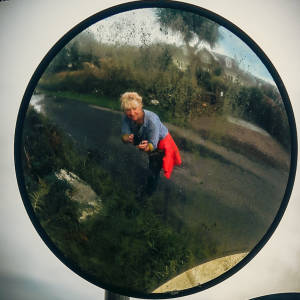A Sunday ramble
Poor Himself woke up feeling rotten today - sore throat, headache chestiness - and remained in bed. Once a covid test had been administered - negative - I'm afraid I left him to it and went on a pre-arranged jaunt to Bandon. I met up with Marguerite who is hosting the talk next week, and as it's in Bandon I thought I better do a recce. We were in search of three wells, none found but we might have identified where they could have been. One was in the grounds of a derelict school. We should have known better but we, respectable ladies of a certain age, both somehow managed to clamber over a padlocked gate : M had a short bout of vertigo and worried about her dodgy knee and I got stuck on the lock. Encouraging comments were made by passersby but in fact we didn't see anything more than if we had behaved ourselves and stood on the correct side of the gate.
Fortified by coffee and pains o chocolat we went to look for a well near the old distillery where rumour had it that the water was used for the brewing. The distillery had in fact long gone but what a magnificent building it was - can you see the bundles of wheat? You hardly ever see brick in West Cork so this was a wonderful confection. The pigeons appreciated it too.
On my way home I tried to find one more well. It sounded interesting but gone:
This well is situated in our land in Curravreeda. This well was also called St. Brigid's Well. It is about twelve yards from the main road which is called the Board of Works Road. The well is noted for the great cures that have been got from its water. Long ago there was a stone on the side of the road to show where the well was. It is said that it weighed six hundredweight. But one evening men were coming from a bowling match and they rolled the stone down the side of the hill. It is now below in the hollow near the well.
Blow me down, there was the stone! I couldn't get any closer as there was a steep ditch, a stream and a thicket of briars but I was delighted the 600weight boulder remained!
And in the local graveyard I came across a very early grave marker inscribed with a date - 1623 - and the evocative epitaph:
Here lieth the body of Ann Dyke
alias, Herrison, a virgin
anno dom 1623
and though after my skinne,
wormes destroy this body
yet shall I see God in my flesh.
Bandon was planted in the early 1600 by English Protestants who were given land in West Cork and promptly built a walled town to separate themselves from the indigenous, Catholic Irish. Ann was one of the very first to arrive, departing from Bristol. She is reputed to have been a nurse, tending the early settlers who were suffering from some sort of contagious disease, maybe plague. She eventually succumbed herself.
Wonders a plenty.

Comments
Sign in or get an account to comment.


